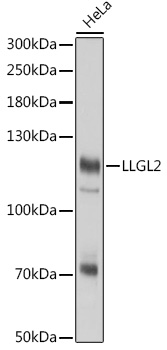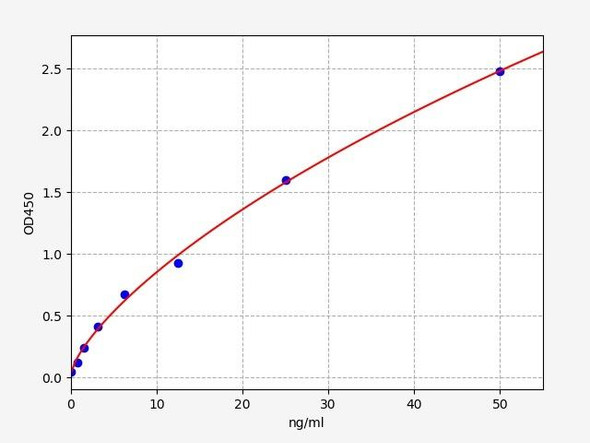Cell Biology Antibodies 18
Anti-LLGL2 Antibody (CAB18366)
- SKU:
- CAB18366
- Product Type:
- Antibody
- Reactivity:
- Human
- Host Species:
- Rabbit
- Isotype:
- IgG
- Research Area:
- Cell Biology
Description
| Antibody Name: | Anti-LLGL2 Antibody |
| Antibody SKU: | CAB18366 |
| Antibody Size: | 20uL, 50uL, 100uL |
| Application: | WB |
| Reactivity: | Human |
| Host Species: | Rabbit |
| Immunogen: | Recombinant protein of human LLGL2. |
| Application: | WB |
| Recommended Dilution: | WB 1:500 - 1:2000 |
| Reactivity: | Human |
| Positive Samples: | HeLa |
| Immunogen: | Recombinant protein of human LLGL2. |
| Purification Method: | Affinity purification |
| Storage Buffer: | Store at -20°C. Avoid freeze / thaw cycles. Buffer: PBS with 0.02% sodium azide, 50% glycerol, pH7.3. |
| Isotype: | IgG |
| Sequence: | Email for sequence |
| Gene ID: | 3993 |
| Uniprot: | Q6P1M3 |
| Cellular Location: | |
| Calculated MW: | 113kDa |
| Observed MW: | 113kDa |
| Synonyms: | HGL, Hugl-2, LGL2, LLGL2 |
| Background: |
| UniProt Protein Function: | LLGL2: Part of a complex with GPSM2/LGN, PRKCI/aPKC and PARD6B/Par-6, which may ensure the correct organization and orientation of bipolar spindles for normal cell division. This complex plays roles in the initial phase of the establishment of epithelial cell polarity. Belongs to the WD repeat L(2)GL family. 3 isoforms of the human protein are produced by alternative splicing. |
| UniProt Protein Details: | Protein type:Cell cycle regulation Chromosomal Location of Human Ortholog: 17q25.1 Cellular Component: cortical actin cytoskeleton; cytoplasm; intracellular membrane-bound organelle; nucleoplasm; plasma membrane Molecular Function:GTPase activator activity; PDZ domain binding; protein binding; Rab GTPase binding; syntaxin binding Biological Process: cortical actin cytoskeleton organization and biogenesis; establishment of spindle orientation; neurogenesis; regulation of establishment and/or maintenance of cell polarity; regulation of exocytosis; regulation of Notch signaling pathway; regulation of protein secretion |
| NCBI Summary: | The lethal (2) giant larvae protein of Drosophila plays a role in asymmetric cell division, epithelial cell polarity, and cell migration. This human gene encodes a protein similar to lethal (2) giant larvae of Drosophila. In fly, the protein's ability to localize cell fate determinants is regulated by the atypical protein kinase C (aPKC). In human, this protein interacts with aPKC-containing complexes and is cortically localized in mitotic cells. Alternative splicing results in multiple transcript variants encoding different isoforms. [provided by RefSeq, Jul 2008] |
| UniProt Code: | Q6P1M3 |
| NCBI GenInfo Identifier: | 93204600 |
| NCBI Gene ID: | 3993 |
| NCBI Accession: | Q6P1M3.2 |
| UniProt Secondary Accession: | Q6P1M3,Q14521, Q9BR62, |
| UniProt Related Accession: | Q6P1M3 |
| Molecular Weight: | 39,668 Da |
| NCBI Full Name: | Lethal(2) giant larvae protein homolog 2 |
| NCBI Synonym Full Names: | LLGL2, scribble cell polarity complex component |
| NCBI Official Symbol: | LLGL2 |
| NCBI Official Synonym Symbols: | HGL; LGL2; Hugl-2 |
| NCBI Protein Information: | lethal(2) giant larvae protein homolog 2 |
| UniProt Protein Name: | Lethal(2) giant larvae protein homolog 2 |
| UniProt Synonym Protein Names: | HGL |
| Protein Family: | Lethal(2) giant larvae protein |
| UniProt Gene Name: | LLGL2 |
| UniProt Entry Name: | L2GL2_HUMAN |







